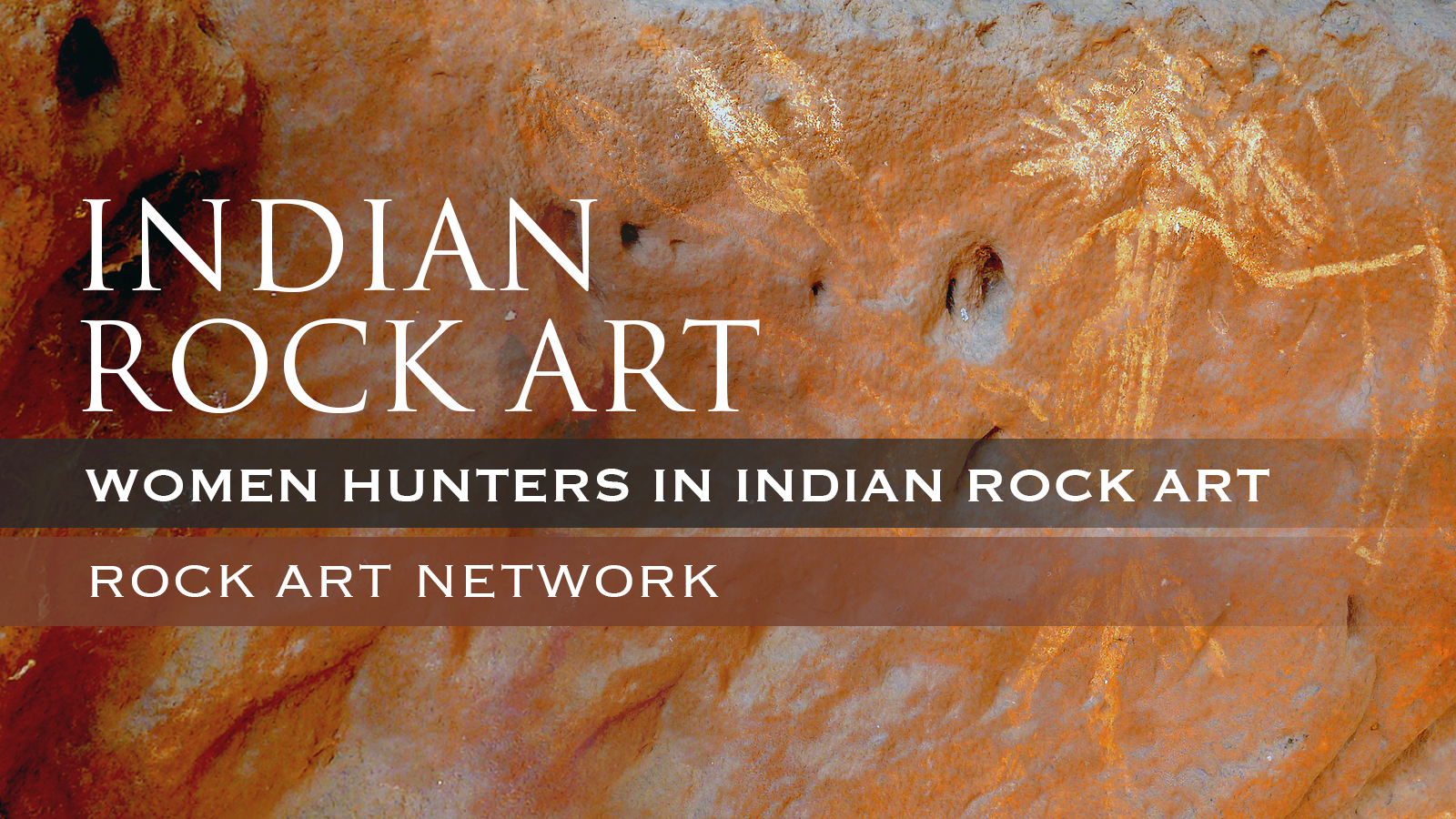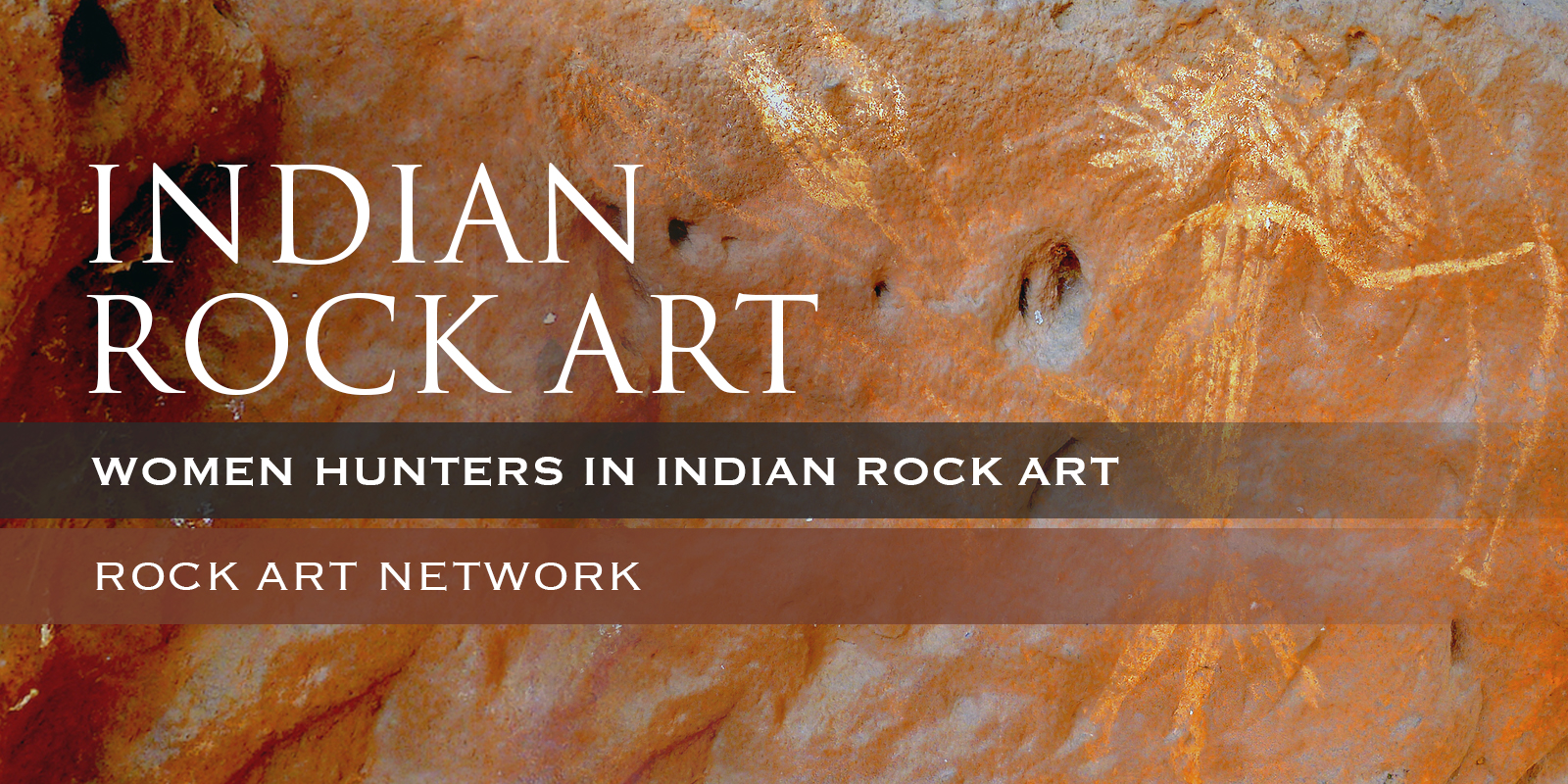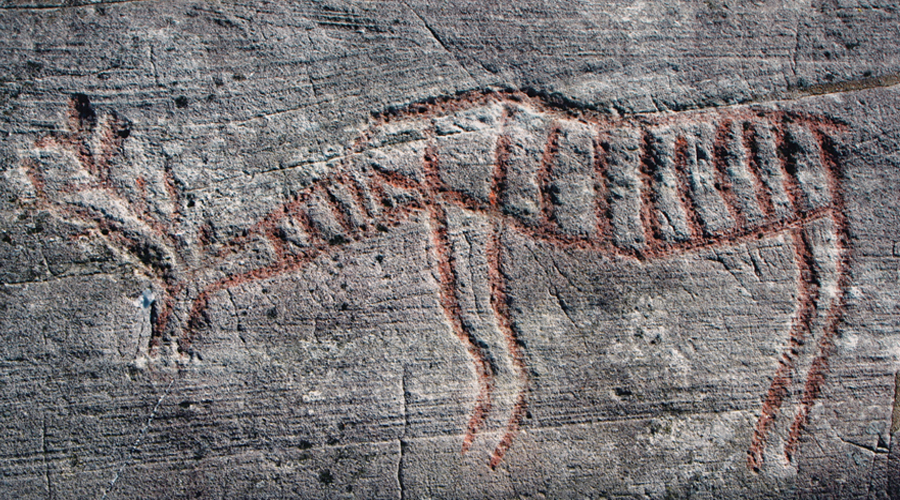


Why do many prehistorians assume that in the Prehistoric times, only men were hunters and women were always gatherers!! Hunter-gatherers lived in the natural surroundings and they knew very well that they depended on each other to survive. They hunt together. Facing hardship in such environments they never felt any importance of gender.
Rock art is the key to better understanding human behaviour in past cultures all over the world. Rock art provides evidence of human social development. Many rituals and ceremonies are passed down to each generation. Still, some tribes obtained their food through hunter-and-gatherer practices just like their ancestors. Indian rock art has been under study for over a century. The pioneers of research on Indian rock art were two Englishmen, Archibald Carlyle who first noticed rock paintings in 1867, and John Cockburn who in 1881 visited painted sites in the Kaimur range (district of Mirzapur). C.A. Silberrad (1907), C.W. Anderson (1918), B. Allchin (1958), D.H. Gordon (1939) and M. Ghosh (1932) also discovered and worked on Indian rock art sites. From 1957 to 1987, V.S. Wakankar discovered many such sites all over India. In particular, he discovered and excavated Bhimbetka and revealed stratified sequences from the Lower Palaeolithic to Early Historic (Wakankar 1975). Madhya Pradesh is the largest Indian State. It is right in the middle of the country and it is the place with most rock art. It is crossed by two mountain ranges, Satpura and Vindhachal, with numerous rock formations with shelters favourable to painting (Dubey-Pathak M. & Clottes J. 2021).
In the early time hunting was the main profession, anyone physically and mentally fit and strong with good stamina to run and chase animals, could be a good hunter. Possibly, old or unfit for hunting people, were supposed to take care of children and other things. Human representations have been very common in Indian rock art from early Mesolithic to modern times. Another huge difference is that in India they are detailed and well characterized. Their actions are diverse, whether one deals with men or with women. We have many examples from Central Indian rock art of women participating in hunting (Dubey-Pathak M. 2020).
In many images, men are shown as stick figures accompanied by rectangular-shaped women holding bows and arrows (Figure 2). During the Mesolithic times women and men both used to wear a single piece of cloth to cover their sex organs. Their uses of ornaments reflect their aesthetic sense and creative mind. On their neck, they wore necklaces made with bone beads. Armlets, bracelets and knee bands could be made with reeds or some kind of bamboo grass. Bird feathers were used to decorate headgear (Figure 3).
Women have actively participated in hunting during Mesolithic times. For example, at Pachmarhi, Bori, A pregnant woman is shown with a bow and three arrows with big arrowheads, her swollen belly indicates her pregnancy, and her face is almost covered with her hair. The style of depiction is Mesolithic. (Figure 4). In a scene of a wild boar hunt, the boar is surrounded by men and women hunters (Figure 5). At Urden in the Raisen district, women and men are chasing animals such as bison, wild buffalo and wild boars to run (Figure 6 & Figure 7). In another scene women and men are holding hands and dancing, two women are sitting and facing each other, one is playing a pipe and another is probably singing. On the lower side, a small woman is stretching an arrow on a bow, while a man in front of her is holding a bow and arrow and dancing. Probably in that scene, they are celebrating a successful hunt (Figure 8). In Bhimbetka nine hunting scenes show women as hunters (Mathpal 1984).
Women have also been shown as fighters. At Adamgarh in the Hoshanabad district, four women are holding bows and arrows and running (Figure 9) in the same direction, probably to fight against another group (Dubey-Pathak Meenakshi 2020).
A pregnant woman is shown with a bow and three arrows with big arrowheads, her swollen belly indicates her pregnancy.
Dancing scene hunters are celebrating a successful hunt. DStretch Ire.
Fruit, herbs and honey gathering were quite prominent activities among prehistoric people. It was Mesolithic people who introduced the art of basket-making and rope-making with palm and bamboo. Mesolithic women are shown carrying baskets on their backs. These baskets are in different shapes and sizes (conical, cylindrical, rectangular or cubical), and can easily stay attached on their backs with a flat strip or ribbon made with grass or leather, which is tied on their foreheads to keep fish, fruit and herbs, such kinds of scenes are numerous in the Raisen and Sehore areas, particularly in Bhimbetka, Jaora and Kathotiya. At Kathotiya, a seated woman in white is holding a rectangular basket with many small fish (Figure 10), probably, she has collected after the fish hunting game.
https://t.co/7He66DIkNT Women Hunters in #India #RockArt. Why do many prehistorians assume that in the #Prehistoric times, only men were hunters & women were always gatherers. #InternationalWomensDay pic.twitter.com/NwtGkqAWaL
— Bradshaw Foundation (@BradshawFND) March 8, 2024
We have many examples from Central Indian tribes. Maria and Muria Gonds, Kamar, Pando and Pahari korwa. They prefer to live in the forest. They have many techniques for hunting games for different animals. Haka or beating drums to chase animals was very popular among the Gonds of Bastar.
Kamar, Pando and Pahari Korwa are still using bows and arrows (Figure 11). Their women were also hunting animals (Figure 12). Though hunting is forbidden nowadays. A woman (Bihani) from the Pahari Korwa community told me that her mother was good at hunting animals with bows and arrows. Still, they hunt wild boar and deer with bows and arrows and small animals such as porcupines, hares, and rats with small traps made out of bamboo sticks frames and snares. Hunt birds with slings and also fish and crabs with bamboo baskets. Women are still playing small hunting games for collecting fish in tribal communities (Figure 13). During my many trips to the Korba forest area, I have noticed that most of the time the couple go together in the hills, to collect fruits, tubers and roots. They have good knowledge about the medicinal value of herbal plants. During their Karma ritual, they also paint animals and symbols on their house wall, which is very similar to the rock art of their area. They dance and sing together.
These natives worship nature. Men and Women both are skilled in doing bamboo work and making bows and arrows (Figure 14 & Figure 15).
A seated woman in white is holding a rectangular basket with many small fish, probably, she has collected after the fish hunting game.
Women do small hunting games for collecting fish. They stop water flow with mud and grass, then troughing remaining water another side of the steam, to catch fish easily.
Man and Woman both are skilled in doing bamboo work and making bows and arrows.
In the Philippines, Agta women still participate in hunting just like their men. They also kill animals like deer, wild boars, monkeys etc. Pregnancy is not stopping their activities, because among the tribe pregnancy is a normal way of life. They always carry babies in slings, to keep their hands free to hunt. Women frequently hunt deer among the Agta (Goodman, Griffin, Estioko-Griffin & Grove, 1985).
Similarly, the Ainu tribes from North Japan, lived on islands to sustain themselves. Hunting was a sacred act, giving and taking between humans and Gods. Women hunted as well as men, though they did so separately and only to feed their close family with their game. (Katarina Sjoberg,1993-52).
Australian Aboriginal women provide meat to their families after hunting. The Mbuti people, or Bambuti, are one of several indigenous pygmy groups in the Congo region of Africa. Hunting is usually done in groups, with men, women, and children all aiding in the process. Both sexes gather and forage. Each band has its hunting ground, In the Central African Republic where women hunt more frequently than men. Central African women hunt for duikers and forest pigs (Noss & Hewlett, 2001).
In the Aka community, Women hunt while men care for children, and vice versa, without stigma or loss of status. Women are not only as likely as men to hunt but can even be more proficient hunters. Aka women have been served hunting even during the late stages of pregnancy and returning to hunting shortly after childbirth, sometimes even carrying newborns while hunting(The Guardian. 2005).
The women from Hadza in Tanzania, the! Kung San in Botswana/Namibia, are also hunters, Ju/’hoan women participate in hunting by tracking. Mbuti women hunters and Aka women hunters, both use nets for hunting animals (Khorasani DG, Lee S-H 2020). The Matsés or Mayoruna are an indigenous people of the Peruvian and Brazilian Amazon rain forest. Mostly couples hunt together and bring more meat than men alone.
Women hunters have a variety of tools to hunt use like bows and arrows, spears, nets, knives, slings, conical baskets and traps made with bamboo. Sometimes they hunt with family, big or small groups and also with dogs. For example, an American Cree women hunt pelt animals alone and in groups (Brightman R.1996).
A biological anthropologist Sarah Lacy, who studies the health of early humans and her colleague Cara Ocobock is a physiologist who makes analogies between the modern day and the fossil record. The team looked at female physiology and found that women were physically capable of being hunters. They found that women are physiologically better at running marathons. A prominent hypothesis contends that early humans are thought to have pursued prey on foot over long distances until the animals were exhausted. Furthermore, the fossil and archaeological records, as well as ethnographic studies of modern-day hunter-gatherers, indicate that women have a long history of hunting games ( Ocobock & Lacy 2023).
Women were prominent hunters in prehistoric times. Female anatomy is good for running. Many contemporary ethnic groups have been forced or compelled to choose a new way of living. But still, some contemporary hunter-gatherers retain a foraging way of life. More than sixty different foraging societies across the world are involved in hunting and gathering practices.
These included nineteen different foraging societies from North America, six from South America, twelve from Africa, fifteen from Australia, five from Asia and six from the Oceanic region. Of the 63 different foraging societies, 50 (79%) of the groups had documentation on women hunting. Of the 50 societies that had documentation on women's hunting, 41 societies had data on whether women's hunting was intentional or opportunistic. In societies where hunting is considered the most important subsistence activity, women actively participated in hunting 100% of the time with various types of hunting games(Anderson et al 2023).
Also, renowned rock art scholar abbé Henri Breuil depicted female toolmakers in his book of 1949, Beyond the Bounds of History: scenes from the Old Stone Age.
1. Abigail Anderson, Sophia Chilczuk, Kaylie Nelson, Roxanne Ruther1, Cara Wall- Scheffler-2023.I.The Myth of Man the Hunter: Women’s contribution to the hunt across ethnographic contexts.
2. Brightman R.1996. The sexual division of foraging labour: Biology, taboo, and gender politics. Comp Stud Soc Hist. 38(4):687–729.
3. Cara Ocobock & Sarah Lacy, 2023. The Theory That Men Evolved to Hunt and Women Evolved to Gather is Wrong. https://www.scientificamerican.com/
4. Dubey-Pathak Meenakshi. 2013. Rock Art of Pachmarhi Biosphere. Mesolithic to Historic Times. Delhi, B.R. Publishing Corporation.
5. Dubey-Pathak Meenakshi 2014. The Rock Art of the Bhimbetka Area in India. Adoranten: (Sweden), 5-22.
6. Dubey-Pathak Meenakshi. 2020. Women in Indian Rock Art. Expression no 27, pp. 20-31. Italy.
7. Dubey-Pathak Meenakshi. 2020. Mother Representations in Central Indian Rock Art. INORA no. 87, Pg. 1-32, France.
8. Dubey-Pathak M. & Clottes J.2021. Madhya Pradesh Rock Art and Tribal Art. New Delhi, INTACH and Aryan publications. India.
9.Katarina Sjöberg,1993. The Return of the Ainu: Cultural Mobilization and the Practice of Ethnicity in Japan (Chur, Switzerland: Harwood Academic Publishers,52.
10. Khorasani DG, Lee S-H.2020. Women in human evolution redux. In: Willermet C, Lee S-H, editors. Evaluating evidence in biological anthropology. Cambridge: Cambridge University Press; p. 11–34.
11. Mathpal, Y.1984. Prehistoric Rock Paintings of Bhimbetka. Abhinav Publications, New Delhi.
12.Noss AJ, Hewlett BS. 2001. The contexts of female hunting in Central Africa. Am Anthropol. 103 (4):1024–40.
13. The Guardian,15 June 2000. Are the men of the African Aka tribe the best fathers in the World? Retrieved 2016-02-09.
14. Wakankar, V.S. 2005, Painted Rock Shelters of India. Archives and Museums. M.P, Bhopal.
→ Members and affiliated institutions of the Rock Art Network
by
George Nash
5/09/2024 Recent Articles
→ Sigubudu: Paintings of people with guns in the northern uKhahlamba-Drakensberg
by Aron Mazel
22/07/2024
by Richard Kuba
13/06/2024
by Meenakshi Dubey-Pathak
8/03/2024
by Rock Art Network
6/02/2024
by Rock Art Network
14/12/2023
by Sam Challis
5/12/2023
by Aron Mazel
30/11/2023
by Sam Challis
21/11/2023
by Sam Challis
15/11/2023
by Sam Challis
10/11/2023
by Rock Art Network
6/11/2023
by Rock Art Network
3/11/2023
by Aron Mazel
2/11/2023
by Meenakshi Dubey-Pathak
26/09/2023
by Paul Taçon
24/08/2023
by Aron Mazel
13/06/2023
by Paul Taçon
5/06/2023
by Paul Taçon
15/03/2023
by George Nash
14/03/2023
by Noel Hidalgo Tan
10/02/2023
by George Nash
01/02/2023
by Meenakshi Dubey-Pathak, Pilar Fatás Monforte
29/11/2022
by Aron Mazel, George Nash
21/09/2022
by Paul S.C. Taçon, Sally K. May, Ursula K. Frederick, Jo McDonald
07/07/2022
by Meenakshi Dubey-Pathak
26/07/2022
by Paul Taçon
20/07/2022
by David Coulson
16 June 2022
by Paul Taçon
25 April 2022
by Noel Hidalgo Tan
20 April 2022
by Meenakshi Dubey-Pathak
14 March 2022
by Carolyn Boyd & Pilar Fatás
02 March 2022
by David Coulson
07 February 2022
by Johannes H. N. Loubser
06 February 2022
by Meenakshi Dubey-Pathak
05 February 2022
by Aron Mazel
28 January 2022
by Aron Mazel
8 September 2021
by David Coulson
17 August 2021
by Ffion Reynolds
21 June 2021


by Aron Mazel
22/07/2024
by Richard Kuba
13/06/2024
by Meenakshi Dubey-Pathak
8/03/2024
by Rock Art Network
6/02/2024
by Rock Art Network
14/12/2023
by Sam Challis
5/12/2023
by Aron Mazel
30/11/2023
by Sam Challis
21/11/2023
by Sam Challis
15/11/2023
by Sam Challis
10/11/2023
by Rock Art Network
6/11/2023
by Rock Art Network
3/11/2023
by Aron Mazel
2/11/2023
by Meenakshi Dubey-Pathak
26/09/2023
by Paul Taçon
24/08/2023
by Aron Mazel
13/06/2023
by Paul Taçon
5/06/2023
by Paul Taçon
15/03/2023
by George Nash
14/03/2023
by Noel Hidalgo Tan
10/02/2023
by George Nash
01/02/2023
by Meenakshi Dubey-Pathak, Pilar Fatás Monforte
29/11/2022
by Aron Mazel, George Nash
21/09/2022
by Paul S.C. Taçon, Sally K. May, Ursula K. Frederick, Jo McDonald
07/07/2022
by Meenakshi Dubey-Pathak
26/07/2022
by Paul Taçon
20/07/2022
by David Coulson
16 June 2022
by Paul Taçon
25 April 2022
by Noel Hidalgo Tan
20 April 2022
by Meenakshi Dubey-Pathak
14 March 2022
by Carolyn Boyd & Pilar Fatás
02 March 2022
by David Coulson
07 February 2022
by Johannes H. N. Loubser
06 February 2022
by Meenakshi Dubey-Pathak
05 February 2022
by Aron Mazel
28 January 2022
by Aron Mazel
8 September 2021
by David Coulson
17 August 2021
by Ffion Reynolds
21 June 2021
Friend of the Foundation


by Aron Mazel
22/07/2024
by Richard Kuba
13/06/2024
by Meenakshi Dubey-Pathak
8/03/2024
by Rock Art Network
6/02/2024
by Rock Art Network
14/12/2023
by Sam Challis
5/12/2023
by Aron Mazel
30/11/2023
by Sam Challis
21/11/2023
by Sam Challis
15/11/2023
by Sam Challis
10/11/2023
by Rock Art Network
6/11/2023
by Rock Art Network
3/11/2023
by Aron Mazel
2/11/2023
by Meenakshi Dubey-Pathak
26/09/2023
by Paul Taçon
24/08/2023
by Aron Mazel
13/06/2023
by Paul Taçon
5/06/2023
by Paul Taçon
15/03/2023
by George Nash
14/03/2023
by Noel Hidalgo Tan
10/02/2023
by George Nash
01/02/2023
by Meenakshi Dubey-Pathak, Pilar Fatás Monforte
29/11/2022
by Aron Mazel, George Nash
21/09/2022
by Paul S.C. Taçon, Sally K. May, Ursula K. Frederick, Jo McDonald
07/07/2022
by Meenakshi Dubey-Pathak
26/07/2022
by Paul Taçon
20/07/2022
by David Coulson
16 June 2022
by Paul Taçon
25 April 2022
by Noel Hidalgo Tan
20 April 2022
by Meenakshi Dubey-Pathak
14 March 2022
by Carolyn Boyd & Pilar Fatás
02 March 2022
by David Coulson
07 February 2022
by Johannes H. N. Loubser
06 February 2022
by Meenakshi Dubey-Pathak
05 February 2022
by Aron Mazel
28 January 2022
by Aron Mazel
8 September 2021
by David Coulson
17 August 2021
by Ffion Reynolds
21 June 2021
Friend of the Foundation






























